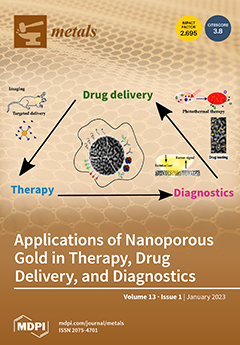Additive manufactured (AM) metals are attractive materials for medical implants, as their geometries are directly produced from computer-aided design (CAD)/computer-aided manufacturing (CAM) data. However, the fatigue properties of AM metals are weak compared with bulk metals, which is an obstacle to the practical
[...] Read more.
Additive manufactured (AM) metals are attractive materials for medical implants, as their geometries are directly produced from computer-aided design (CAD)/computer-aided manufacturing (CAM) data. However, the fatigue properties of AM metals are weak compared with bulk metals, which is an obstacle to the practical applications of AM metals. To improve the fatigue properties of AM metals, we developed a mechanical surface treatment using laser cavitation. When we irradiate a pulsed laser to a metallic surface in water, laser ablation is generated, and a bubble that behaves like a cavitation is produced. The bubble is referred to as a “laser cavitation”. In the surface treatment using laser cavitation, we use the plastic deformation caused by the impact force at the bubble collapse and pulsed laser energy that produces local melting at the same time. Thus, the mechanical surface treatment using laser cavitation is a type of surface mechanical alloying. In this study, to demonstrate the improvement in the fatigue properties of AM metals, we treated titanium alloy Ti6Al4V, which was manufactured by direct metal laser sintering (DMLS), with laser cavitation, and we evaluated the surface morphology, roughness, residual stress, hardness, and finally tested it using a torsion fatigue test. Unmelted particles on the DMLS surface, which cause fatigue cracks, were melted and resolidified using laser cavitation, resulting in a reduction of the maximum heights of roughness (
Rz) of about 75% and the arithmetical mean roughness (
Ra) of about 84% of the non-peened one. Although tensile residual stresses of about 80–180 MPa were generated on the as-built surface, compressive residual stresses of about −80 MPa were introduced by laser cavitation. Furthermore, laser cavitation formed Ti
4O
5 oxide film, which increased the surface hardness by about 106%. Finally, we performed torsional fatigue tests and revealed that laser cavitation extended the fatigue life from 19,791 cycles to 36,288 cycles at an applied shear stress (
τa) at 460 MPa, which is effective in suppressing crack initiation.
Full article





